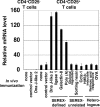Definition of target antigens for naturally occurring CD4(+) CD25(+) regulatory T cells
- PMID: 15753203
- PMCID: PMC2212825
- DOI: 10.1084/jem.20041959
Definition of target antigens for naturally occurring CD4(+) CD25(+) regulatory T cells
Abstract
The antigenic targets recognized by naturally occurring CD4(+) CD25(+) regulatory T cells (T reg cells) have been elusive. We have serologically defined a series of broadly expressed self-antigens derived from chemically induced mouse sarcomas by serological identification of antigens by recombinant expression cloning (SEREX). CD4(+) CD25(+) T cells from mice immunized with SEREX-defined self-antigens had strong suppressive activity on peptide-specific proliferation of CD4(+) CD25(-) T cells and CD8(+) T cells. The suppressive effect was observed without in vitro T cell stimulation. Foxp3 expression in these CD4(+) CD25(+) T cells from immunized mice was 5-10 times greater than CD4(+) CD25(+) T cells derived from naive mice. The suppressive effect required cellular contact and was blocked by anti-glucocorticoid-induced tumor necrosis factor receptor family-related gene antibody. In vitro suppressive activity essentially disappeared 8 wk after the last immunization. However, it was regained by in vitro restimulation with cognate self-antigen protein but not with control protein. We propose that SEREX-defined self-antigens such as those used in this study represent self-antigens that elicit naturally occurring CD4(+) CD25(+) T reg cells.
Figures




References
-
- Sakaguchi, S., N. Sakaguchi, M. Asano, M. Itoh, and M. Toda. 1995. Immunologic self-tolerance maintained by activated T cells expressing IL-2 receptor α-chains (CD25). Breakdown of a single mechanism of self-tolerance causes various autoimmune diseases. J. Immunol. 155:1151–1164. - PubMed
-
- Shevach, E.M. 2002. CD4+ CD25+ suppressor T cells: more questions than answers. Nat. Rev. Immunol. 2:389–400. - PubMed
-
- Sakaguchi, S. 2004. Naturally arising CD4+ regulatory T cells for immunologic self-tolerance and negative control of immune responses. Annu. Rev. Immunol. 22:531–562. - PubMed
-
- Malek, T.R., A. Yu, V. Vincek, P. Scibelli, and L. Kong. 2002. CD4 regulatory T cells prevent lethal autoimmunity in IL-2Rβ-deficient mice. Implications for the nonredundant function of IL-2. Immunity. 17:167–178. - PubMed
Publication types
MeSH terms
Substances
LinkOut - more resources
Full Text Sources
Other Literature Sources
Molecular Biology Databases
Research Materials

